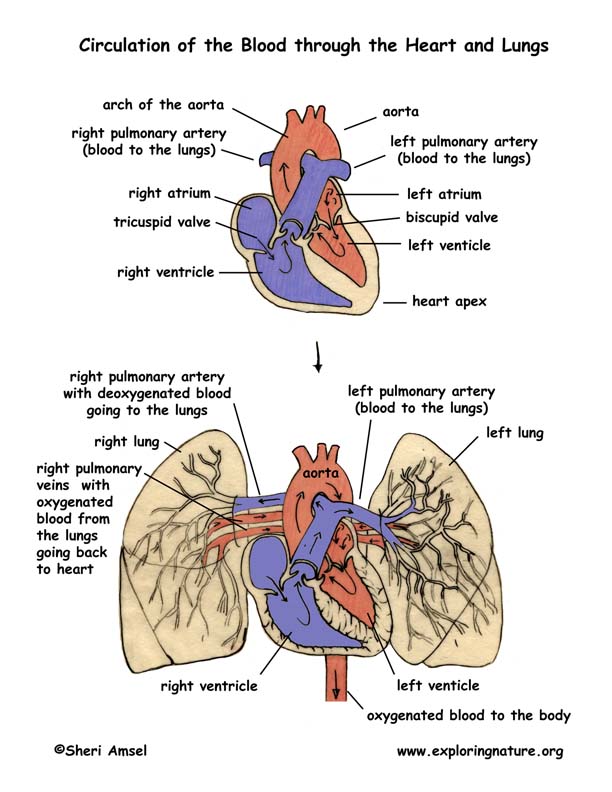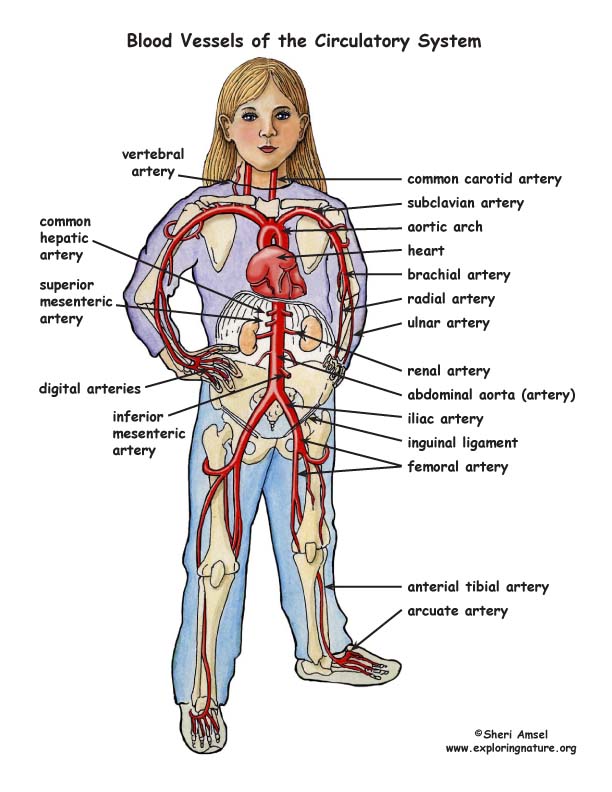

Your heart never stops beating because it is pumping blood around your body day and night. This is very important, because your blood carries oxygen to all the organs and tissues of your body. The bodys tissues need to have oxygen every minute to survive.
The blood picks up oxygen that is inhaled into the lungs and delivers it by via blood vessels, the arteries, to every tissue of the body.
At the same time the blood picks up the waste, carbon dioxide, and delivers it via blood vessels, the veins, to the lungs to be gotten rid of when you exhale.
The lub dub sound of the heart beating is the sound of the heart's valves opening and closing as the heart contracts and squeezes the blood on its way. Your heart beat speeds up when you exercise because your muscles need more oxygen, so your heart must work faster to supply it.
Our blood is pushed all around our bodies by the heart, a powerful pump. Your heart is about the size of your fist and grows with you as you grow. The heart is made of muscle and weighs less than a pound. It lies between the lungs, protected inside the ribcage. The human heart has four chambers; 2 atria on the top and 2 ventricles on the bottom. The atria are separated from the ventricles by valves. Valves are important because they keep the blood flowing forward.
Blood circles through the heart, which pumps it to the lungs where it picks up oxygen - this is called pulmonary circulation. Then the heart pumps the blood to the rest of the body - this is called systemic circulation.
Pulmonary Circulation:
In pulmonary circulation, the venous blood comes back to the heart through two big veins called the vena cava. It flows into the right atrium. Then it passes through the tricuspid (3-cupped) valve into the right ventricle. From there it is pumped through the pulmonary arteries to the lungs. In the lungs it picks up oxygen and drops off carbon dioxide. Then it comes back to the heart through the pulmonary veins (only veins in the body carrying oxygenated blood) and flows into the left atrium. Then it goes through the bicuspid (2-cupped) valve (also called the mitral valve) into the left ventricle. The left ventricle, the most muscular and powerful chamber in the heart, pumps the blood through the aorta, the largest artery in the body.
Blood flow through the heart: vena cava - right atrium - tricuspid valve - right ventricle - pulmonary arteries - lungs - pulmonary veins - left atrium - bicuspid valve - left ventricle - aorta
From here the blood flows to the whole body, bringing oxygen to the tissues that need it. Now it enters the systemic circulation.
______________________________________________________________________________________________________________
In summary, the circulatory system has several roles:
1. The blood brings oxygen from the lungs and nutrients from the digestive tract to all the tissues (and cells) of the body.
2. The blood brings metabolic waste from the cells to where they will be discarded – carbon dioxide to the lungs and nitrogenous waste to the kidneys.
3. The blood brings hormones from endocrine organs to body organs on which they need to act.
4. The blood helps maintain normal body temperature, pH, and body fluid volume.
5. The blood prevents infection with white blood cells, antibodies and plasma proteins and stops blood loss by clotting via platelets and plasma proteins.
__________________________________________________________________________________
TESTING
Assess knowledge of the Circulatory System with the Mutiple Choice Test.
Study the Blood Vessels Named, then test your knowledge with the Blood Vessels Labeling.
Assess knowledge of Blood Flow Through the Heart with this Multiple Choice
__________________________________________________________________________
When you research information you must cite the reference. Citing for websites is different from citing from books, magazines and periodicals. The style of citing shown here is from the MLA Style Citations (Modern Language Association).
When citing a WEBSITE the general format is as follows.
Author Last Name, First Name(s). "Title: Subtitle of Part of Web Page, if appropriate." Title: Subtitle: Section of Page if appropriate. Sponsoring/Publishing Agency, If Given. Additional significant descriptive information. Date of Electronic Publication or other Date, such as Last Updated. Day Month Year of access < URL >.
Amsel, Sheri. "A Circulatory System Overview & Assessment" Exploring Nature Educational Resource ©2005-2024. December 13, 2024
< http://www.exploringnature.org/db/view/Circulatory-System-Overview-and-Assessment >

